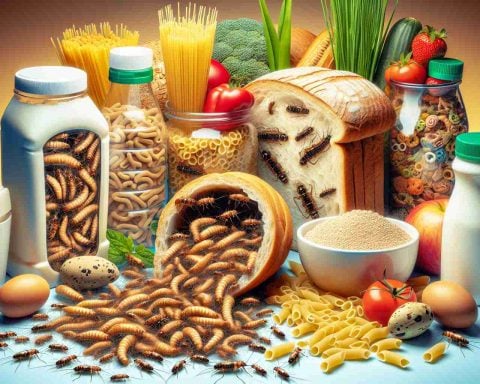- The EU will allow the use of UV-treated mealworm powder in various foods starting February 10, 2025.
- Mealworms are a sustainable protein alternative, containing nearly double the protein of meat.
- Grasshoppers provide significant nutritional benefits, including high protein, calcium, and iron content.
- Consumers should check ingredient labels for insect-derived products, which will be clearly identified.
- Insect consumption is already common in many cultures, promoting sustainability in food production.
In a bold move towards sustainability, the European Union is ushering in a new era of edible insects. From February 10, 2025, a revolutionary regulation will allow UV-treated mealworm powder to sneak into your breads, pastries, and even cheeses! This shift is more than a culinary adventure; it’s a mission to establish alternative protein sources that are not only climate-friendly but also nutritious.
Imagine biting into a fluffy loaf of bread, only to discover it could contain up to 4 grams of mealworm powder per 100 grams! While it may sound off-putting, these critters offer a nutritional powerhouse, boasting nearly double the protein of meat, along with essential vitamins and minerals. For instance, grasshoppers can provide 12.9% protein, 76 milligrams of calcium, and 9.5 milligrams of iron per 100 grams.
Consumers need to become savvy shoppers, as the presence of insects in your foods will often be a hidden surprise. Look closely at ingredient lists for scientific names like Acheta domesticus (house cricket) and Tenebrio molitor (mealworm). However, they must not appear in vegetarian or vegan products and will be clearly labeled with their form—be it powdered or paste.
While some may cringe at the thought of munching on insects, they are a culinary staple in many cultures worldwide. This new directive not only aims to provide an innovative protein source but also to curb the environmental impact of traditional farming. Keep your eyes peeled; your next snack might just be a surprising delicacy!
Discovering Edible Insects: The Future of Sustainable Eating!
The European Union’s upcoming regulation to incorporate edible insects, starting February 10, 2025, goes beyond just a novel food trend; it signifies a significant leap toward sustainability. With this regulation, UV-treated mealworm powder will become an accepted ingredient in various food products like breads, pastries, and cheeses. Here’s what you need to know:
Key Features of Edible Insects
1. Nutritional Benefits: Edible insects are a rich source of protein. For example, mealworms contain about 20-25% protein, making them a viable protein alternative to traditional meats.
2. Environmental Impact: Insect farming has a much lower carbon footprint compared to livestock farming. It uses less land, water, and feed, thus promoting sustainability.
3. Culinary Adaptability: Edible insects can easily be integrated into varied recipes due to their subtle flavor profile, enabling them to enhance dishes without overwhelming them.
Pros and Cons of Edible Insects
Pros:
– Highly nutritious, providing essential vitamins and minerals.
– Sustainable and environmentally friendly compared to conventional protein sources.
– Potential to alleviate global food shortages by providing alternative protein.
Cons:
– Cultural resistance in many regions where insect consumption is not common.
– Potential allergens for some individuals.
– Regulatory challenges in categorizing food products inclusive of insect ingredients.
Market Forecast for Edible Insects
The edible insect market is projected to grow significantly, driven by increasing awareness of environmental issues and nutritional benefits. According to market analyses, the industry is anticipated to reach $1.5 billion by 2028, with growth rates accelerating as consumers embrace alternative protein sources.
Limitations and Considerations
Despite their benefits, consumer acceptance remains a challenge. Educational initiatives will be vital to inform the public about the safety and advantages of integrating edible insects into the diet. Transparency in labeling and clear guidelines will be crucial to ensure that consumers feel confident in their choices.
Sustainability Insights
Insect farming is not just about alternative protein; it encourages a more sustainable food system. Insects convert feed into protein more efficiently than cattle, thereby reducing greenhouse gas emissions. Their production also lessens biodiversity loss associated with traditional agriculture.
Related Questions
1. What types of insects are considered safe for human consumption?
Many insects are deemed safe, including mealworms (Tenebrio molitor), crickets (Acheta domesticus), and grasshoppers. They are typically farmed under regulated conditions. Always look for certifications and labeling to ensure their safety.
2. How will the regulation affect current food products?
The introduction of insect protein in food products is likely to expand the market for innovative snacks and meals. It may also encourage traditional food manufacturers to adapt their recipes, creating new product lines that meet regulatory standards.
3. How can consumers identify foods containing insect proteins?
Consumers should check ingredient labels for scientific names associated with edible insects. Terms like “mealworm powder,” “cricket flour,” or “insect protein” will be explicitly stated to guide informed choices.
For more information on edible insects and their integration into your diet, visit the EUFIC website.

















